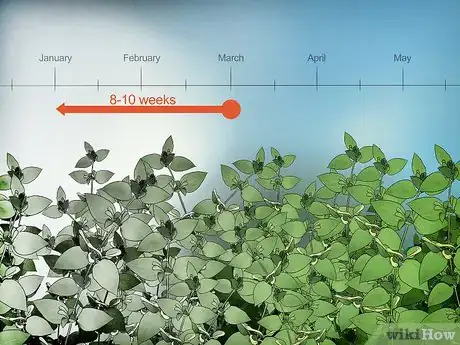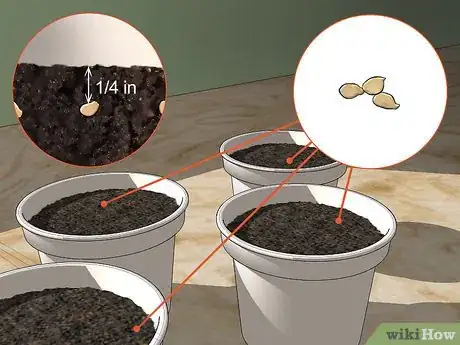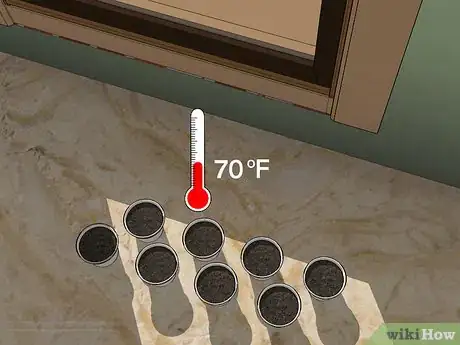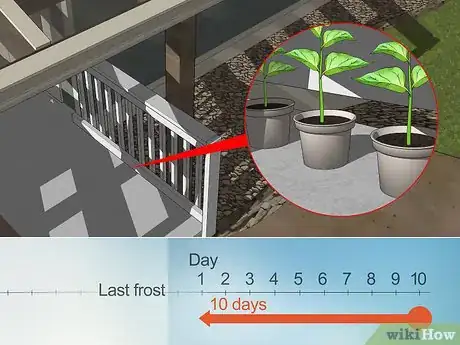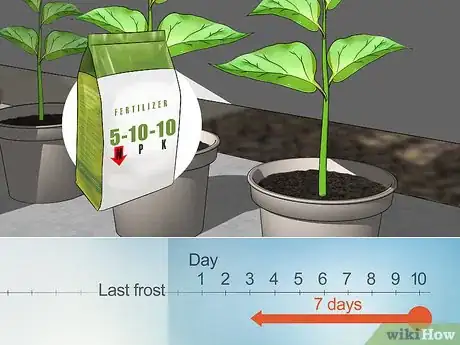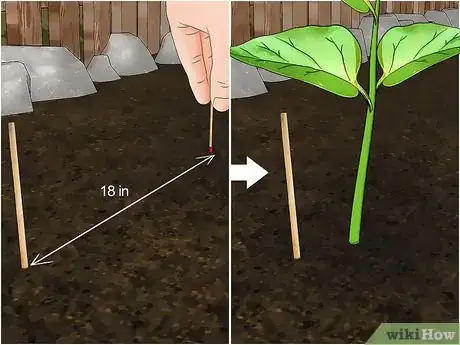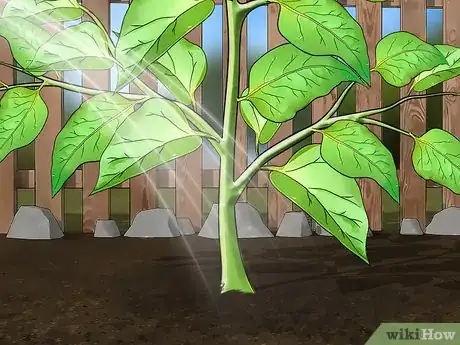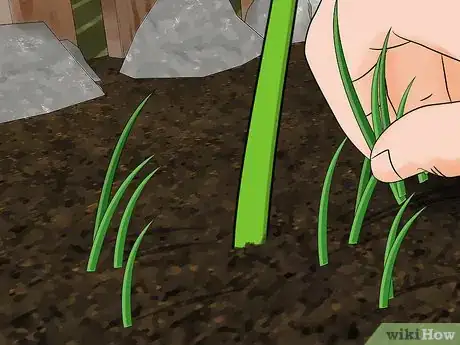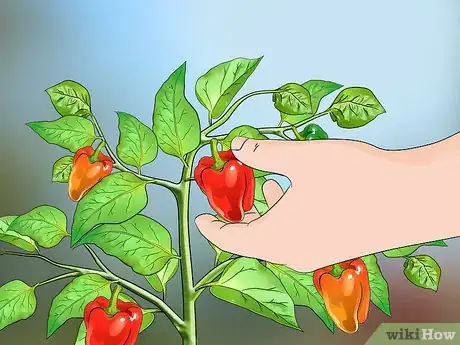This article was co-authored by Lauren Kurtz. Lauren Kurtz is a Naturalist and Horticultural Specialist. Lauren has worked for Aurora, Colorado managing the Water-Wise Garden at Aurora Municipal Center for the Water Conservation Department. She earned a BA in Environmental and Sustainability Studies from Western Michigan University in 2014.
There are 8 references cited in this article, which can be found at the bottom of the page.
This article has been viewed 26,945 times.
Bell peppers can be a delicious addition to any meal. Whether you like the red, yellow or green variety, you can grow your own bell pepper plants at home from seeds. By germinating your seeds indoors, transitioning your plants outside, and caring for your pepper plants, you’ll be enjoying homegrown peppers in no time.
Steps
Germinating Seeds Indoors
-
1Calculate the last frost date for your area. Pepper seeds should be planted 8-10 weeks before the last frost date. The Old Farmer’s Almanac can help you calculate the last frost date for where you live to determine what week you should plant your seeds. You will transfer your seeds outside just after the last frost date.[1]
-
2Plant three seeds per container ¼ in (1/2 cm) deep. Use any pot or vessel the size of a yogurt cup or larger with a hole in the bottom to plant seeds.[2] Use a fine-textured seed-starting mix, such as Black Gold Seeing Mix or a natural potting mix like compost, coco fiber, and perlite, that allows a lot of drainage.[3] Water your seeds to the point of dampness but not saturation.
- Never allow your seeds’ soil to dry out completely.[4]
Advertisement -
3Keep your seeds in a room at least 70 degrees F (21 degrees C). Pepper seeds require warmth to germinate. Find a room in your house that gets good sun and maintains a temperature of at least 70 degrees F (21 degrees C).[5] You can use a wall thermometer to determine the temperature if your thermostat is unreliable.
-
4Remove the weakest seedling. Pepper plants thrive best in pairs, as the two plants can shade each other from excess sun. A few weeks into the seedlings growth, remove the one that is thriving least so the other two can flourish.[6]
Transitioning the Plants Outside
-
1Acclimate your plants to the outdoors slowly before transplantation. Before moving your pepper plant outside permanently, place your pepper plants in a sheltered spot outside, such as under a patio awning for a few hours, increasing the amount of time daily. Start the pepper plants outside for two hours at a time and gradually increase the outdoor time over the coming days, bringing the plants in for exceptionally cold or rainy weather.[7]
- This process of acclimating your plants to outdoor weather is called hardening off.
- Ensure outdoor temps are not cooler than 65 degrees F (18 degrees C) for hardening. If there is no threat of frost, you can even leave the plants out overnight. Don't leave your plants outside overnight until the end of hardening off, though.
-
2Introduce your plants to fertilizer. About a week before transplantation, introduce your plants to fertilizer by adding a tablespoon per every gallon of your potting soil.[8] Opt for a balanced 2-2-2 fertilizer during this stage of growth. Later, when the plants start to flower, you can switch them to a low-nitrogen fertilizer.[9]
-
3Plant the seedlings with a few matchsticks at the root if the soil is not acidic enough. On a good weather day shortly after last frost date, use a trowel to dig a hole for your plants in your yard. Place a few matchsticks in the hole before transferring the plants. The acidic sulfur in the match heads encourages your pepper plants to take to the soil.[10] The size of the hole will depend on the size of your plant, but cover a little of your plant’s base in new topsoil.
- If you are transplanting multiple paired plants, space them 18 to 24 in (45 to 60 cm) apart.[11]
Caring for Your Pepper Plants
-
1Water your pepper plants 1-2 in (2.5-5 cm) a week. Watering plants in inches or centimeters just indicates how much rainwater would need to accumulate in a container for your plant to get an appropriate watering. If it helps measure how much water you give your plants, you can put an empty tuna can next to your plants that fills as you water. Water your peppers more frequently if you live in an arid or desert climate. [12]
-
2Weed around your pepper plants. Weeds compete with your pepper plants for sunlight and nutrients in the soil.[13] Remove weeds at the root to ensure they don’t grow back and disturb your vegetable garden.
-
3Harvest your peppers when they reach your desired size. When your peppers look ready, pick them, wash and eat. Fertilize your plants with low-nitrogen fertilizer after your first fruit harvest to keep them growing well.[14]
Expert Q&A
-
QuestionHow long does it take for a pepper seed to sprout?
 Lauren KurtzLauren Kurtz is a Naturalist and Horticultural Specialist. Lauren has worked for Aurora, Colorado managing the Water-Wise Garden at Aurora Municipal Center for the Water Conservation Department. She earned a BA in Environmental and Sustainability Studies from Western Michigan University in 2014.
Lauren KurtzLauren Kurtz is a Naturalist and Horticultural Specialist. Lauren has worked for Aurora, Colorado managing the Water-Wise Garden at Aurora Municipal Center for the Water Conservation Department. She earned a BA in Environmental and Sustainability Studies from Western Michigan University in 2014.
Professional Gardener This will depend on the conditions the seeds are being sprouted in. The warmer the environment, the faster the seeds will sprout. This usually takes at least 2 weeks.
This will depend on the conditions the seeds are being sprouted in. The warmer the environment, the faster the seeds will sprout. This usually takes at least 2 weeks.
Things You'll Need
- Pot
- Pepper seeds
- Water
- Low-nitrogen fertilizer
- Trowel
- Matches
- Tuna can
References
- ↑ http://www.almanac.com/gardening/frostdates/IL/Chicago
- ↑ http://www.johnnyseeds.com/growers-library/vegetables/growing-tips-successful-pepper-transplants.html
- ↑ http://www.johnnyseeds.com/growers-library/vegetables/growing-tips-successful-pepper-transplants.html
- ↑ https://www.growveg.com/guides/how-to-grow-peppers-in-containers/
- ↑ http://www.almanac.com/plant/bell-peppers
- ↑ http://www.almanac.com/plant/bell-peppers
- ↑ http://www.almanac.com/video/how-successfully-harden-indoor-sown-plants
- ↑ https://www.planetnatural.com/fertilizing-potted-plants/
- ↑ http://www.almanac.com/plant/bell-peppers
